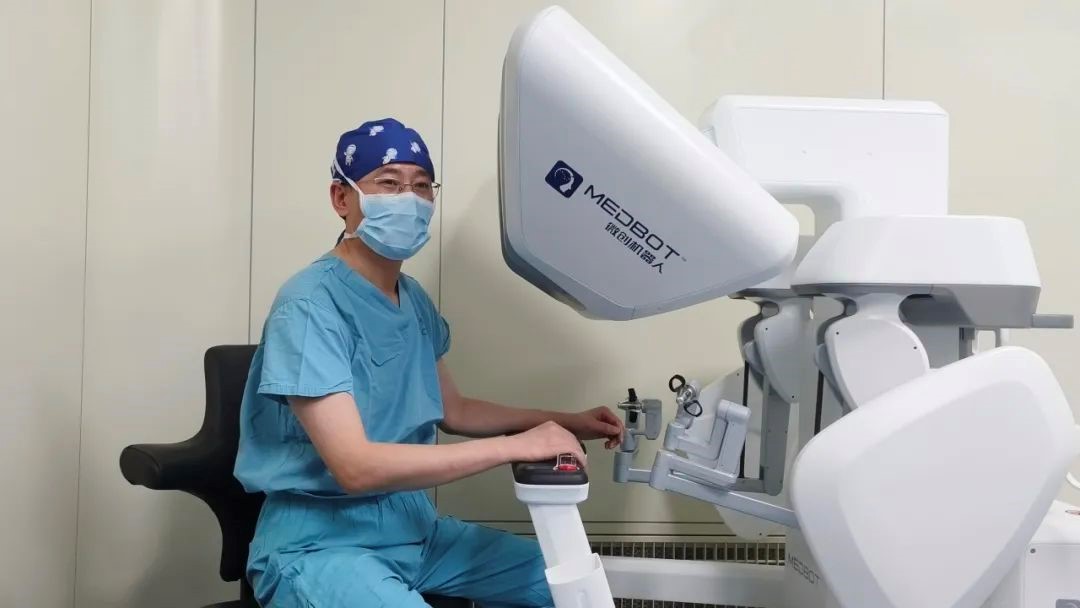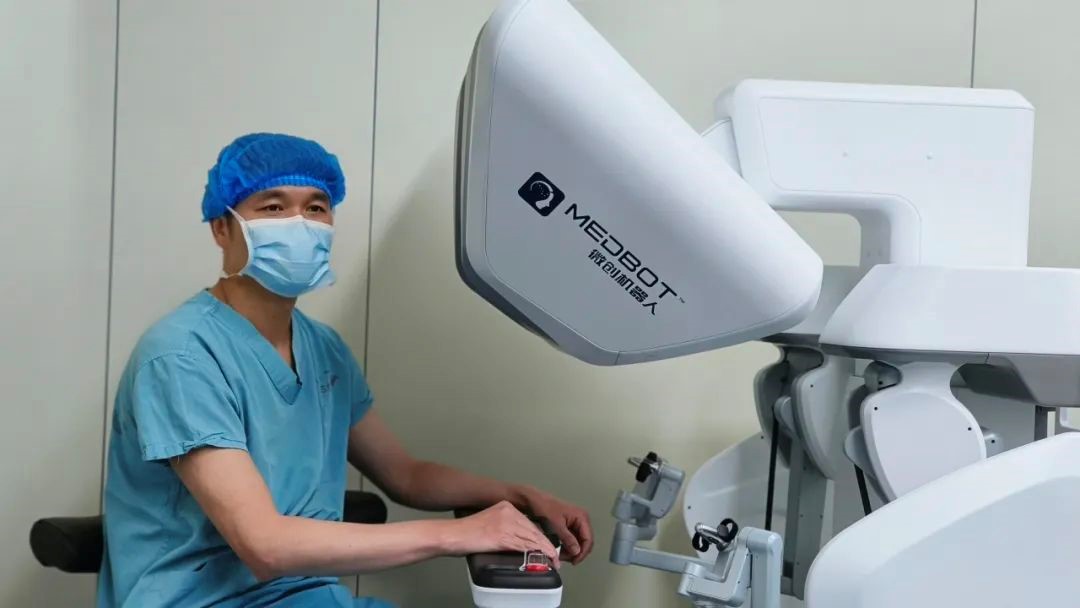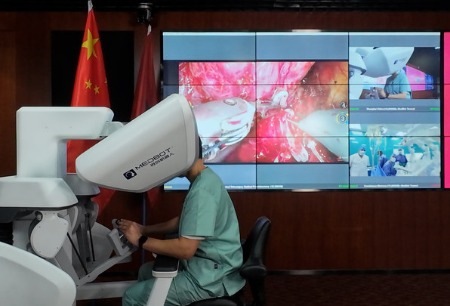Since the introduction of the first Chinese-developed Toumai® surgical robot at Jingzhou First People's Hospital (referred to as Jingzhou Hospital), this advanced medical device has become a well-deserved "star" in the eyes of doctors and patients. Breaking through the limitations of human hands, the surgical robot offers advantages such as minimal intraoperative bleeding, smaller incisions, and faster postoperative recovery. Patients who have heard about it have been making appointments in large numbers, specifically requesting the surgical robot. Young and middle-aged experts from various departments at Jingzhou Hospital have also shown great favor towards the first Chinese-developed surgical robot in Jingzhou. Within a week, they have completed multiple robot-assisted surgeries consecutively and successfully expanded its application to multiple departments. This has allowed patients in the Jingzhou area to enjoy advanced, high-quality, and accessible medical solutions brought about by technological progress, greatly improving their postoperative quality of life. The stability, precision, flexibility, effectiveness, and short learning curve demonstrated by Toumai® have instilled confidence among more hospital experts in the clinical application and popularization of Chinese-developed surgical robots.

Integration of Medical Technology and Innovation
Accelerating Iterative Optimization of Chinese-developed Surgical Robots
Surgical robotics is a high-threshold field that requires constant innovation and breakthroughs. For MicroPort® MedBot®, to stand out in the field of surgical robots, it is necessary to focus on core technology research and development, strengthen collaboration between medicine and engineering, listen to the clinical needs, continuously absorb feedback and suggestions, and gradually optimize and iterate the Toumai® robot step by step. This process aims to address clinical pain points and embed doctors' experience and workflows into the product, making it more mature and user-friendly.
During the clinical and scientific research validation of Toumai®, Jingzhou Hospital has accumulated a wealth of experience. Director Dai Haitao not only performed the first robot-assisted laparoscopic surgery at Jingzhou Hospital but also conducted clinical surgical practices for various diseases, including resection of pheochromocytoma, partial nephrectomy, radical cystectomy with lymph node dissection for bladder cancer, and radical prostatectomy.
Director Dai Haitao strives for excellence in surgical operations but is not satisfied with the current situation. "To do a good job, one must first sharpen one's tools." Based on his years of clinical experience and more than ten clinical surgical experiences assisted by Toumai®, he has put forward many improvement suggestions and recommendations for the Toumai ®. He practices the integration of medicine and engineering and promotes continuous improvement, optimization, and upgrades of Chinese-developed surgical robots, aiming to truly achieve " Making surgery easier, safer and less invasive. "
Recently, Director Dai Haitao operated on multiple difficult urological surgeries using the iterative version of Toumai®. He also conducted the first live broadcast of robot-assisted surgeries in Jingzhou City, successfully completing the highly challenging radical cystectomy with ileal conduit urinary diversion for bladder cancer. After the surgery, urology colleagues in Jingzhou area congratulated him. Director Dai Haitao admitted that these surgical experiences greatly exceeded his expectations. At the provincial urology conference, experts and professors from major hospitals in the province also showed great interest in the successful implementation of robot-assisted surgeries at Jingzhou Hospital. When asked about his experience with the Toumai®, Director Dai Haitao described it as a "transformational change."
Indeed, the optimized and iterative Toumai® surgical system has made significant improvements in surgical visualization, flexibility of the robotic arms, and can cover almost all surgical specialties. It particularly demonstrates its advantages in the treatment of difficult and complex cases, aligning with the modern surgical concept of "precision, minimally invasive, and rapid recovery."
Director Dai Haitao has high expectations for the deployment of Toumai® in the hospital and the operation of the Toumai® Surgical Robot Training Center. He emphasizes that patient safety is always the top priority, and the use of laparoscopic surgical robots requires a solid foundation in surgical techniques. It also requires teamwork involving surgeons, anesthesiologists, and operating room nurses. Therefore, standardized training and team building are essential. "We look forward to learning more advanced treatment concepts and surgical skills from renowned domestic hospitals and experts through training. Only by applying them in clinical practice can we truly safeguard the health of patients!"

Realizing the Dream of Chinese-developed Surgical Robots
"Difficult and Complex Cases" Becoming Routine
Exploration, dissection, resection, suturing... Recently, Dr. Cheng Shaoping and his team from the Department of Urology at Jingzhou First People's Hospital successfully performed multiple difficult and minimally invasive robotic-assisted urological surgeries, including radical nephroureterectomy, ureteral bladder reimplantation, posterior approach partial nephrectomy, and radical cystectomy.
Among them, a patient with renal pelvis cancer insisted on having robot-assisted surgery and waited in the ward for several days. According to Dr. Cheng Shaoping, the scope of radical nephroureterectomy includes the kidney, perirenal fat, hilar lymph nodes, and the entire ureter, with a large surgical range, extensive clearance, and long longitudinal axis. Moreover, the patient had a history of previous colon cancer surgery, severe abdominal adhesions, and the surgery was challenging for both the surgeon and the robot.
Thanks to the high degree of freedom of the Toumai® robot's robotic arms and the wristed surgical instruments that surpass human limitations, the surgical operating range is larger, and the robot is more flexible than human hands in narrow anatomical areas. This facilitates the surgeon in performing extensive tissue traction, dissection, and cutting. The high-definition immersive naked-eye 3D vision enlarges the surgical area by 10 times and provides natural depth perception, making the anatomical structures more clearly visible. This allows the surgeon to accurately identify and differentiate tissue layers, facilitating meticulous and precise tissue handling and achieving high-quality suturing. The blood loss is also reduced, which helps further reduce the incidence of complications and improve surgical safety, ensuring the smooth completion of the surgery. So far, Dr. Cheng Shaoping's team has completed 14 urological surgeries assisted by the Toumai® robot, including more than ten complex and difficult procedures involving resection and reconstruction, all with good therapeutic effects.
"Treating major diseases without leaving the county and severe diseases without leaving the city" is a phrase that Dr. Cheng Shaoping often says. Now, with the assistance of the Toumai® robot, Dr. Cheng Shaoping continues to challenge difficult and complex surgeries, breaking through technical barriers one by one, and turning "difficult and complex cases" into "routine."
"Twenty years have passed in the blink of an eye, and the dream is finally coming true!" said Dr. Cheng Shaoping. Using robots for surgery was his biggest dream. From hearing about robotic surgery for the first time in 2001 to performing robot-assisted surgeries for patients as the primary surgeon with the assistance of Toumai® in August 2022, it took Dr. Cheng Shaoping nearly 22 years.
In Dr. Cheng Shaoping's view, patient trust and good postoperative recovery are the greatest driving forces and achievements. The recognition and gratitude from patients are the greatest motivation for doctors to move forward.

Application Across Departments
Toumai® Makes Surgery More Precise and Minimally Invasive
"I hardly felt any pain or discomfort during the surgery, and my recovery was very fast. The robot-assisted surgery made me feel very reassured and satisfied!" These were the words of a female patient after undergoing distal pancreatectomy with the assistance of Dr. Lu Haofeng.
The patient, Aunt Li (pseudonym), is 67 years old and had a history of open cholecystectomy for gallbladder cancer at the hospital seven years ago. When she was admitted this time and learned that she needed a pancreatectomy, she felt very fearful and anxious. After learning about the patient's concerns, Dr. Lu Haofeng explained in detail the steps of robot-assisted surgery and the postoperative recovery process, patiently comforting the patient and gradually restoring her confidence, allowing the treatment to proceed smoothly.
According to the introduction, pancreatic surgery is one of the most complex and high-risk procedures in abdominal surgery, considering both the anatomical position and structural characteristics. In addition, Aunt Li had previous open surgery, and the surgical area had severe tissue adhesions, making the surgery quite challenging. Although it was the first time for Dr. Lu Haofeng to perform surgery using the Toumai®, he did not feel any discomfort. During the surgery, he skillfully controlled the four robotic arms from the Toumai® console, allowing the dexterous wristed surgical instruments to accurately avoid important organs around the lesion and meticulously dissect the vital blood vessels around the pancreas. The advantages of the Toumai® in "precise identification, precise dissection, and meticulous resection" were fully demonstrated in this surgery, which was successfully completed with significantly reduced blood loss.
The successful completion of the distal pancreatectomy with robot assistance marks a new milestone for Jingzhou First People's Hospital in the field of minimally invasive surgery. It not only demonstrates the hospital's technical strength in robot-assisted surgery but also showcases the professional competence and exquisite skills of Dr. Lu Haofeng and his team, bringing more advanced and precise medical services to patients.
After the surgery, Dr. Lu Haofeng stated that robot-assisted surgery is an important direction of development in the field of surgery today. It can improve the precision and safety of surgery and provide better treatment outcomes for patients. In the future, he will continue to dedicate himself to the research and clinical application of robot-assisted surgery, providing better medical services to more patients.
Mr. Liu Yu, Executive Vice President and Chief Commercial Officer of MedBot ®, stated that enabling patients to recover quickly is the tireless pursuit of every doctor. With the assistance of Toumai®, the directors and experts at Jingzhou First People's Hospital have accurately, safely, and efficiently completed surgeries in multiple departments and specialties, promoting the recovery process of patients and improving their quality of life and emotional well-being. This embodies the social significance and value of technological empowerment for medical progress. Currently, Toumai® has been put into use at Jingzhou First People's Hospital, and the training center has been established and put into operation. This will cultivate and reserve more specialized surgical robot talents for Jingzhou and even the entire Hubei Province, allowing advanced technology to be better applied in clinical practice and achieving the goal of " Make surgery easier, safer and less invasive."









 Hu ICP Bei No. 20013662 HGWA Bei No. 31011502015178
Hu ICP Bei No. 20013662 HGWA Bei No. 31011502015178 " are registered trademarks of Shanghai MicroPort Medical (Group) Co., Ltd.” . They have been authorized to be used by Shanghai Microport Medbot (Group) Co., Ltd., and no other party shall use such trademarks without prior written permission thereof.
" are registered trademarks of Shanghai MicroPort Medical (Group) Co., Ltd.” . They have been authorized to be used by Shanghai Microport Medbot (Group) Co., Ltd., and no other party shall use such trademarks without prior written permission thereof.
